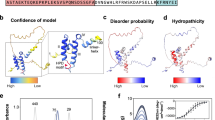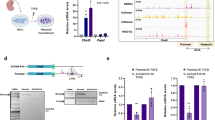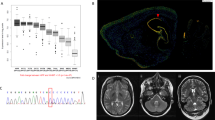Abstract
The J-domain is believed to be part of a chaperone involved in protein folding. From a fetal brain cDNA library, we isolated a cDNA of 3249 bp encoding a novel human J-domain protein, which was named as HDJ3. The expression pattern of HDJ3 was examined by reverse transcription/polymerase chain reaction, which suggested that the transcripts were highly expressed in human pancreas and selectively expressed in human brain, lung, liver, skeletal muscle and kidney. The results also showed that a probable splice variant of HDJ3 gene might exist. The HDJ3 gene was located on human chromosome 12q13.1–12q13.2 and consisted of seven exons spanning 8593 bp of the human genome. PSORT analysis indicated that the HDJ3 gene contained a transmembrane domain. The putative protein of the HDJ3 gene was highly homologous to rat dopamine-receptor-interacting protein, suggesting that it was a novel member of the molecular chaperone family and functionally related to dopamine signal transduction.
Similar content being viewed by others
Log in or create a free account to read this content
Gain free access to this article, as well as selected content from this journal and more on nature.com
or
References
Bermak JC, Li M, Bullock C, Zhou QY (2001) Regulation of transport of the dopamine D1 receptor by a new membrane-associated ER protein. Nat Cell Biol 3:492–498
Cheetham ME, Caplan AJ (1998) Structure, function and evolution of DnaJ: conservation and adaptation of chaperone function. Cell Stress Chaperones 3:28–36
Ellis RJ, Van SM (1991) Molecular chaperones. Annu Rev Biochem 60:321–347
Huang YY, Kandel ER (1995) D1/D5 receptor agonists induce a protein synthesis-dependent late potentiation in the CA1 region of the hippocampus. Proc Natl Acad Sci USA 92:2446–2450
Kanazawa M, Terada K, Kato S, Mori M (1997) HSDJ, a human homolog of DnaJ, is farnesylated and is involved in protein import into mitochondria. J Biochem 121:890–895
Kelley WL (1998) The J-domain family and the recruitment of chaperone power. Trends Biochem Sci 23:222–227
Kozak M (1987) An analysis of 5'-noncoding sequences from 699 vertebrate message RNAs. Nucleic Acids Res 15:8125–8148
Lund PA (1995) The roles of molecular chaperones in vivo. Essays Biochem 29:113–123
Ma Y, Greener T, Pacold ME, Kaushal S, Greene LE, Eisenberg E (2002) Identification of domain required for catalytic activity of auxilin in supporting clathrin uncoating by Hsc70. J Biol Chem 107 (in press)
Misselwitz B, Staeck O, Matlack KE, Rapoport TA (1999) Interaction of BiP with the J-domain of the Sec63p component of the endoplasmic reticulum protein translocation complex. J Biol Chem 274:20110–20115
Nishikawa SI, Fewell SW, Kato Y, Brodsky JL, Endo T (2001) Molecular chaperones in the yeast endoplasmic reticulum maintains the solubility of proteins for retrotranslocation and degradation. J Cell Biol 153:1061–1070
Rinck G, Birghan C, Harada T, Meyers G, Thiel HJ, Tautz N (2001) A cellular J-domain protein modulates polyprotein processing and cytopathogenicity of a pestivirus. J Virol 75:9470–9482
Wall D, Zylicz M, Georgopoulos C (1994) The NH2-terminal 108 amino acids of the Escherichia coli DnaJ protein stimulate the ATPase activity of DnaK and are sufficient for lambda replication. J Biol Chem 269:5446–5451
Wu Z, Yao N, Le HV, Weber PC (1998) Mechanism of autoproteolysis at the NS2-NS3 junction of the hepatitis C virus polyprotein. Trends Biochem Sci 23:92–94
Acknowledgments
This research was funded by a grant from the Natural Science Foundation of China (30100192).
Author information
Authors and Affiliations
Corresponding author
Additional information
J. Chen and Y. Huang contributed equally to this work
Electronic database information: the accession number and URL for the data in this article are as follows:
GenBank, http://www.ncbi.nlm.nih.gov/Genbank (accession no. AY188447)
Rights and permissions
About this article
Cite this article
Chen, J., Huang, Y., Wu, H. et al. Molecular cloning and characterization of a novel human J-domain protein gene (HDJ3) from the fetal brain. J Hum Genet 48, 217–221 (2003). https://doi.org/10.1007/s10038-003-0012-8
Received:
Accepted:
Published:
Issue date:
DOI: https://doi.org/10.1007/s10038-003-0012-8
Keywords
This article is cited by
-
Cluster analysis and significance of novel genes related to molecular classification of glioma
Chinese Journal of Clinical Oncology (2005)



